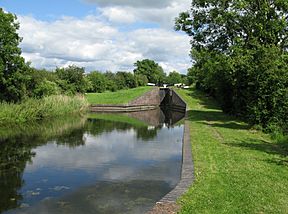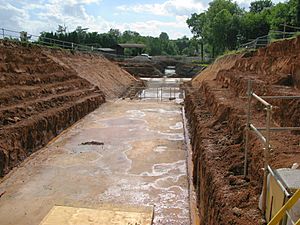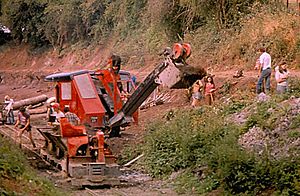Droitwich Canal facts for kids
Quick facts for kids Droitwich Canals |
|
|---|---|

One of the Hanbury locks
|
|
| Specifications | |
| Maximum boat length | 71 ft 6 in (21.79 m) (originally 64 ft 0 in or 19.51 m) |
| Maximum boat beam | 7 ft 0 in (2.13 m) (originally 14 ft 6 in or 4.42 m) |
| Locks | 14 |
| Status | Navigable |
| Navigation authority | Canal and River Trust |
| History | |
| Original owner | Sir George Duckett |
| Principal engineer | James Brindley |
| Date of act | 1768 |
| Date completed | 1771, 1854 |
| Date closed | 1939 |
| Date restored | 2010 (Barge Canal) |
| Geography | |
| Start point | Hanbury |
| End point | Claines |
| Connects to | Worcester and Birmingham Canal, River Severn |
The Droitwich Canal is actually two canals in Worcestershire, England. These are the Droitwich Barge Canal and the Droitwich Junction Canal. The Barge Canal is a wide canal. It opened in 1771. It connected Droitwich Spa to the River Severn at Hawford Bottom Lock, Claines.
The Droitwich Junction Canal is a narrow canal. It opened later, in 1854. This canal linked Droitwich to the Worcester and Birmingham Canal. Both canals were built to transport salt. They stopped being used in 1939. People started planning to restore them in 1973. The Barge Canal officially reopened in 2010. The Junction Canal reopened in July 2011. Now, the Canal and River Trust looks after them.
Contents
History of the Droitwich Canal
Droitwich has been famous for making salt for a very long time. People got salt from natural brine springs, even before Roman times. To get the salt to buyers, people tried to make the River Salwarpe better for boats. They got permission in 1662, but the work stopped in 1675.
There were many attempts to improve the rivers. In 1747, Simon Wood tried again to make the river navigable. In 1755, there was a plan to build a pipeline to carry the salty water to the River Severn. But these plans did not work out.
Building the First Canal
As more salt was being made, Droitwich Council asked James Brindley for help. He was a famous canal engineer who built the Bridgewater Canal. He surveyed a route from the town to the River Severn in 1767. The next year, in 1768, a special law was passed. This law allowed The Company of Proprietors of the Droitwich Canal Navigation to build the canal.
Brindley was the "Inspector of the Works". But he was also busy building the Trent and Mersey Canal. So, John Priddey, the local engineer, sent a builder to learn from Brindley. Construction started on 27 June 1768. The project cost about £23,500 in total.
The canal was built wide enough for large boats called Severn Trows. These boats were about 14.5 feet (4.4 meters) wide and 64 feet (19.5 meters) long. The canal was about 5.7 miles (9.2 km) long. It had eight locks, which helped boats go up or down a total of 56.5 feet (17.2 meters). The water in the canal was salty because of the brine springs. This meant fresh-water fish could not live there.
The canal officially opened on 12 March 1771. It was very successful for business.
How the Canal Operated
Later, the Worcester and Birmingham Canal was being planned. The Droitwich Canal company worried it would lose money. So, they made an agreement in 1790. The new canal company promised to pay them if their profits dropped. The Worcester and Birmingham Canal company even took over managing the Droitwich Canal in 1810.
A tax on salt was removed in 1822 and 1825. This helped the Droitwich Canal earn more money. But then, in 1830, a new source of brine was found at Stoke Prior. This meant more salt was carried by land or other canals.
To compete, a new law was passed in 1852. This allowed the Droitwich Junction Canal to be built. It would connect the barge canal to the Worcester and Birmingham Canal. The Worcester and Birmingham Canal company agreed to rent both Droitwich canals.
The locks on the barge canal were made longer. This allowed bigger boats to carry coal and salt without having to move the goods to smaller boats. This work finished in mid-1854. The Junction Canal opened in late 1854. It was a narrow canal, for boats about 7 feet (2.1 meters) wide. It was one of the last canals built during the "Canal Mania" time. It was about 1.75 miles (2.8 km) long and had six more locks. The main cargo on both canals was always salt.
Decline of the Canals
Over time, the canals faced more challenges. Railways started to take away their business. In 1874, a new company, the Sharpness New Docks & Gloucester & Birmingham Navigation Company, took over the Droitwich Canals. They tried to improve the canals. For example, they removed a lot of mud in 1881. They also changed the locks to allow a depth of 6 feet (1.8 meters).
But by 1906, it cost more to maintain the canals than they earned. The canals slowly fell into disrepair. Finally, a law was passed in July 1939 to officially abandon them. The last boat used the barge canal in 1916. The Junction Canal had not seen any boats since 1928.
Restoring the Droitwich Canals
People in Droitwich started talking about what to do with the canals in 1963. Max Sinclair suggested restoring them. The local council saw how useful the canals could be for fun and tourism. A group was formed in 1969 to work on restoring them.
In 1973, the Droitwich Canals Trust was created. This group, with local support, began working to restore the canal. In October 1973, many volunteers from the Waterway Recovery Group came together to help. In 1975, the canal was one of thirteen projects to get help from a special job program. This program provided paid workers for restoration.
Funding and Progress
Money for the restoration came from many places. Wychavon District Council gave £200,000 in 1980. This helped build a place for boats to moor in Vines Park. Shell also helped fund a new swing bridge. The next year, a job program provided 15 workers and money for materials.
A part of the barge canal in Vines Park opened in October 1986. This allowed the Trust's boat to offer longer trips. In 1994, a study showed that restoring the canal was possible. It would also bring economic benefits to the area. Local authorities supported the idea and looked for more funding.
In 2002, British Waterways estimated the project would cost about £9.5 million. Two years later, the Heritage Lottery Fund gave £4.6 million. Other money came from Advantage West Midlands and local councils. British Waterways then took over the canals from the Trust. By April 2007, £10.5 million had been promised. The Restoration Partnership needed to raise £1 million more to get the rest of the money.

The project was planned to take two years. The goal was to fully restore both Droitwich Canals by 2009. Most of the 7-mile (11 km) canal was still there. But a 550-yard (500-meter) section near the M5 motorway had to be completely rebuilt. A tunnel for a stream was used to help the canal pass under the motorway.
The Barge Canal and the Junction Canal are now connected. This was done by making a 600-yard (550-meter) part of the River Salwarpe wider and deeper. This section runs through the center of Droitwich. The Droitwich Barge Canal officially opened on 11 September 2010. The entire canal system was finished by mid-2011. The grand opening was held on 1 July.
Points of interest
| Point | Coordinates (Links to map resources) |
OS Grid Ref | Notes |
|---|---|---|---|
| Jn with Worcs and B'ham Canal | 52°15′54″N 2°06′54″W / 52.2650°N 2.1151°W | SO922629 | |
| M5 culvert | 52°16′02″N 2°08′00″W / 52.2672°N 2.1332°W | SO910632 | |
| Barge Lock | 52°16′11″N 2°08′44″W / 52.2696°N 2.1456°W | SO901635 | |
| Ladywood Lock | 52°14′52″N 2°11′40″W / 52.2478°N 2.1944°W | SO868610 | |
| A449 Hawford Bridge | 52°14′17″N 2°13′34″W / 52.2381°N 2.2261°W | SO846600 | |
| Jn with River Severn | 52°14′15″N 2°13′56″W / 52.2374°N 2.2322°W | SO842599 |
Images for kids



